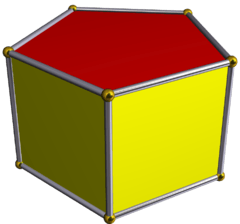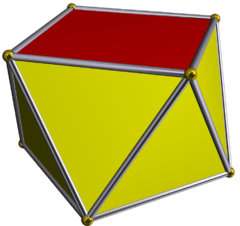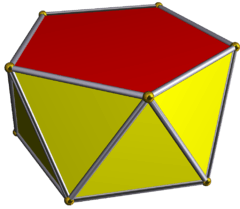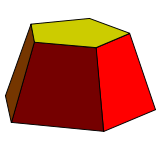Prismatoid
In geometry, a prismatoid is a polyhedron whose vertices all lie in two parallel planes. Its lateral faces can be trapezoids or triangles.[1] If both planes have the same number of vertices, and the lateral faces are either parallelograms or trapezoids, it is called a prismoid.[2]
.svg.png)
Volume
If the areas of the two parallel faces are A1 and A3, the cross-sectional area of the intersection of the prismatoid with a plane midway between the two parallel faces is A2, and the height (the distance between the two parallel faces) is h, then the volume of the prismatoid is given by [3] or (This formula follows immediately by integrating the area parallel to the two planes of vertices by Simpson's rule, since that rule is exact for integration of polynomials of degree up to 3, and in this case the area is at most a quadratic function in the height.)
Prismatoid families
| Pyramids | Wedges | Parallelepipeds | Prisms | Antiprisms | Cupolae | Frusta | ||
|---|---|---|---|---|---|---|---|---|
 |
 |
 |
 |
 |
 | |||
Families of prismatoids include:
- Pyramids, in which one plane contains only a single point;
- Wedges, in which one plane contains only two points;
- Prisms, whose polygons in each plane are congruent and joined by rectangles or parallelograms;
- Antiprisms, whose polygons in each plane are congruent and joined by an alternating strip of triangles;
- Star antiprisms;
- Cupolae, in which the polygon in one plane contains twice as many points as the other and is joined to it by alternating triangles and rectangles;
- Frusta obtained by truncation of a pyramid;
- Quadrilateral-faced hexahedral prismatoids:
- Parallelepipeds – six parallelogram faces
- Rhombohedrons – six rhombus faces
- Trigonal trapezohedra – six congruent rhombus faces
- Cuboids – six rectangular faces
- Quadrilateral frusta – an apex-truncated square pyramid
- Cube – six square faces
Higher dimensions
In general, a polytope is prismatoidal if its vertices exist in two hyperplanes. For example, in four dimensions, two polyhedra can be placed in two parallel 3-spaces, and connected with polyhedral sides.

A tetrahedral-cuboctahedral cupola.
References
- William F. Kern, James R Bland, Solid Mensuration with proofs, 1938, p.75
- Claudi Alsina, Roger B. Nelsen: A Mathematical Space Odyssey: Solid Geometry in the 21st Century. The Mathematical Association of America, 2015, ISBN 9780883853580, pp. 85-89
- B. E. Meserve, R. E. Pingry: Some Notes on the Prismoidal Formula. The Mathematics Teacher, Vol. 45, No. 4 (April 1952), pp. 257-263